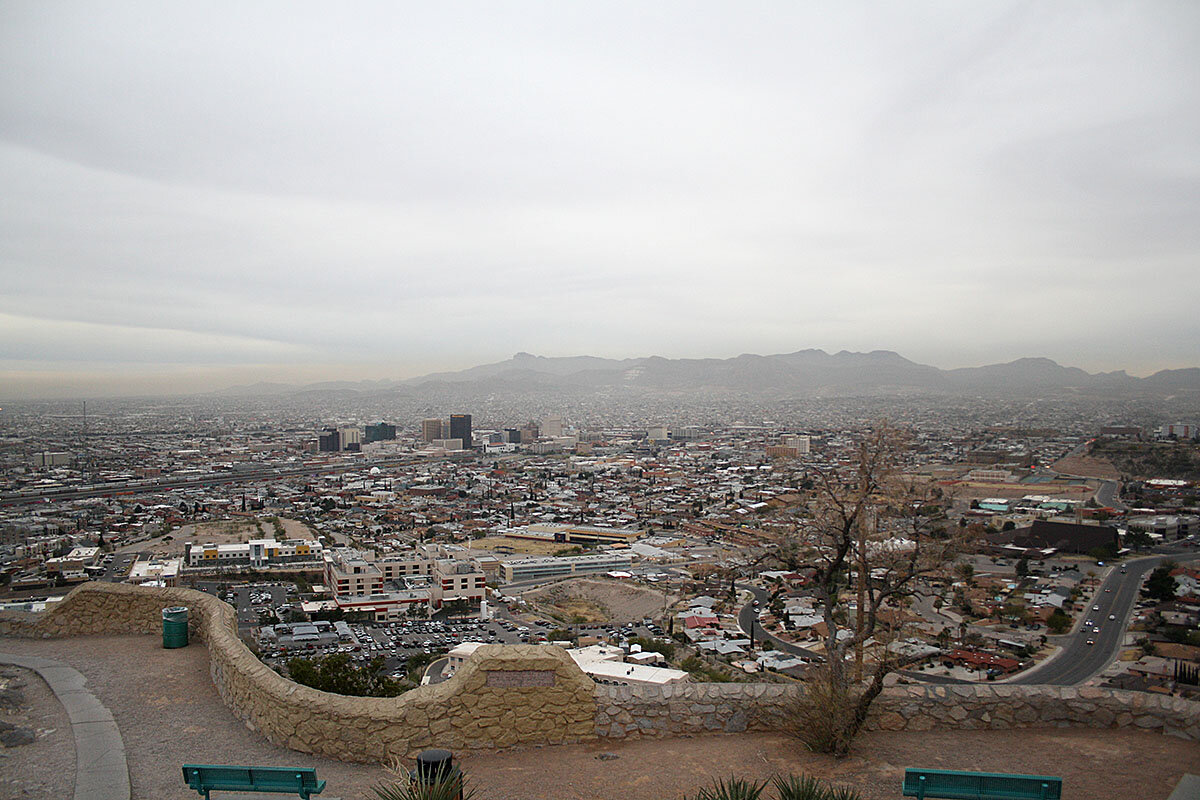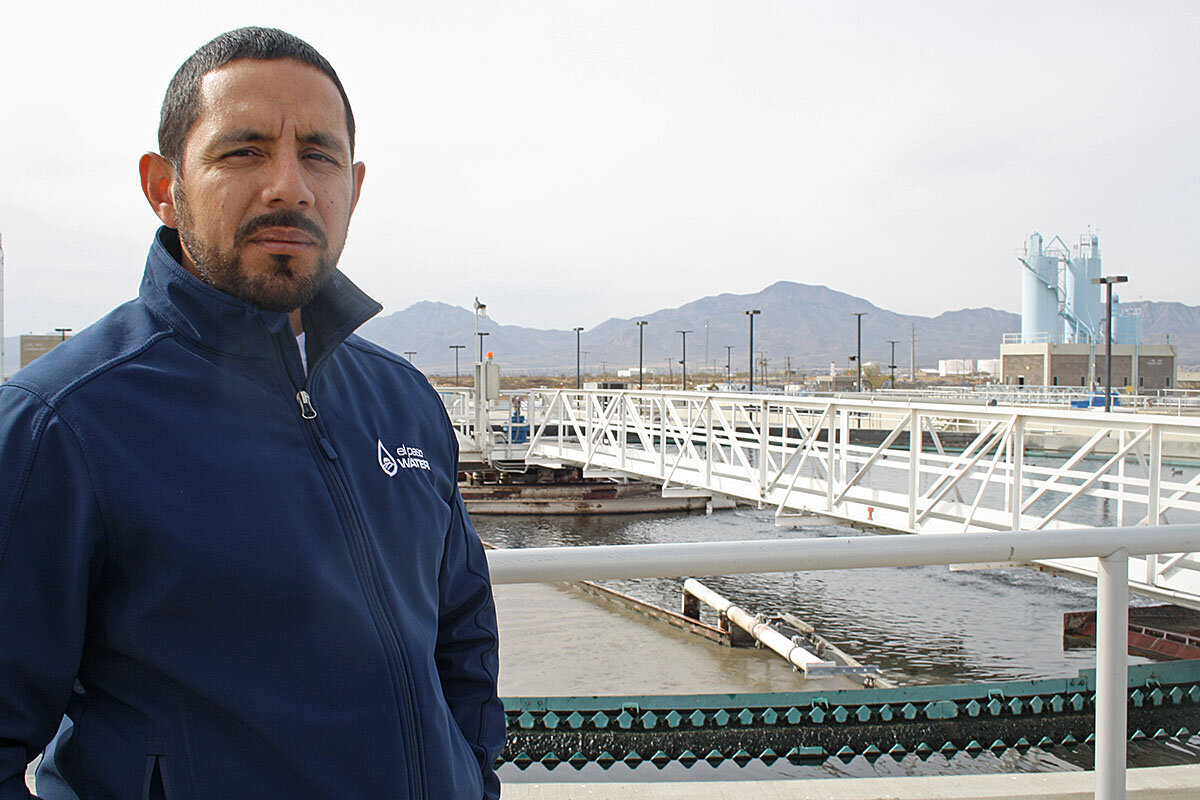One border crisis averted? How Juárez and El Paso became sister cities.
Loading...
| Ciudad Juárez, Mexico; and El Paso, Texas
At the northern end of the Chihuahuan Desert two cities are both divided and united by water.
The Rio Grande helped form the town of Paso del Norte in the 16th century, but centuries later it became the border between El Paso, Texas, and Ciudad Juárez, Mexico.
Beneath the ground, however, the two cities still share the Hueco Bolson aquifer. In the arid climate, fresh groundwater from the aquifer has been crucial in helping them grow. In recent decades they have been helping each other study and manage the resource as it becomes even more important in the face of climate change.
Why We Wrote This
As water scarcity fuels conflicts around the world, sister cities along the US-Mexican border have found mutual success by working together rather than turning against each other.
Aquifers are difficult to manage even in the best of circumstances – they can stretch for thousands of miles, sink for thousands of feet, and they’re entirely underground. When you’re measuring something that crosses an international border it becomes even more difficult. Predicting how much it could hold in the future more difficult still, which is the main thing officials in El Paso and Juárez have been trying to do since they began working together in the mid-1980s.
With surface water from the Rio Grande becoming increasingly unreliable – due in large part to climate change, experts say – extending the life of the Hueco is becoming increasingly important.
“The aquifer doesn’t recognize borders,” says Zhuping Sheng, director of the Texas A&M AgriLife Research Center in El Paso, “so both sides have to come up with solutions to better manage and share the resources.”
Leading the way
Water experts in the Southwest talk about Edmund Archuleta the way basketball fans talk about LeBron James, or film buffs about Federico Fellini – a once-in-a-generation figure who transformed their profession.
There were few, if any, conservation programs under way when Mr. Archuleta joined the El Paso Water (EPW) in 1989. The city’s population had doubled in three decades, and in some areas the Hueco was dropping two or three feet a year.
“That was unsustainable, obviously,” says Archuleta.
He opened and expanded wastewater treatment plants. He bought land north and west of the city to preserve the groundwater supply. In 2007, the utility opened the largest inland desalination plant in the world to treat the Hueco’s brackish groundwater.
Probably his crowning achievement though was the wholesale culture shift he engineered in El Paso water use. Excess users were named, shamed, and fined. Water cops patrolled the streets and a generation of children grew up learning about water conservation from Willie the Water Drop, a smiley blue mascot with a red bandana who visited local schools. In 1985, El Pasoans were using on average 205 gallons of water a day. By 2001, average daily usage dropped to 155 gallons a day, and by 2017 just 128.
Archuleta was also the first water manager in El Paso to reach out to water managers in Juárez. Before then, the two cities communicated through the International Boundary and Water Commission, an international body that governs surface water shared by the United States and Mexico.
“It was very slow to get any information going back and forth, so I just went directly to the [Juárez] water utility,” he says. “We shared data, we began to have regular meetings. We knew what they were doing and planning, they knew what we were doing and planning.”
Gilbert Trejo was a graduate student at The University of Texas at El Paso (UTEP) at the time and part of a team of academics who used the data to model how both cities were using their groundwater.
“It was just odd for these two agencies to be sharing information with each other. That was my feeling as a student,” he recalls.
Today, Mr. Trejo is the EPW’s chief technical officer, and there’s “a genuine trust between the agencies.” The EPW talks once or twice a year with JMAS, the Juárez utility.
“If either one of us mismanages the aquifer or has poor data or incorrect data associated with it, it’ll lead toward poor decisions that will affect them and will ultimately affect us, or vice versa,” he says.
“There's no doubt that [Juárez] is going to have to do everything that we’re doing at some point,” he says.
Water as a human right?
On a chilly early December morning in Puerto de Anapra, a poor Juárez neighborhood about 2.5 miles due west of UTEP, residents line up outside a small concrete booth, waiting to fill up empty 19 liter jugs with drinking water.
Juárez differs in many ways from El Paso when it comes to managing its share of the Hueco – the city’s entire drinking water supply is taken from the aquifer, for one – but here may be the starkest difference. Policing water use in El Paso was a problem for a time, but charging El Pasoans for water never has been. In Mexico water is considered a human right.
It sounds noble, but some water experts in Juárez see it differently. Humberto Uranga, head of water culture and communication at JMAS in Juárez, calls it “free water.”
“Water is a human right, but every human right is linked to a responsibility,” he says, and it’s a responsibility he thinks too many people in Juárez are neglecting. “It is impossible to keep giving away money, because sooner or later we are going to pay the consequences.”
Like El Paso, Juárez has seen almost nonstop growth in recent years. JMAS water connections have increased from about 235,000 to 465,000 in 20 years, Mr. Uranga says. But while El Paso’s groundwater extractions have steadily declined since 1990, they have continued to increase south of the border.
Juárez isn’t standing still, but its efforts to diversify its water sources and ease pressure on the Hueco are progressing slowly, hobbled by financial, political, and cultural challenges.
As Juárez has had to supply water for more people, it has given much of it away free of charge. Of all the water JMAS produces, 40 percent is supplied at no cost. Some residents, like those in Anapra, get it free, as do public schools, parks, hospitals, and government buildings. At the same time, budget crunches at the federal level have limited government investment.
In the short term this has effected the utility’s ability to maintain what water infrastructure it does have, and in the long term it has affected the ability to build new infrastructure, according to René Franco, an independent water consultant in Juárez.
“The fees charged by both utilities are drastically different, [but] the cost of infrastructure is not that much different,” he writes in an email. “JMAS must increase their users fees to get them a little bit closer to the real cost” of water.
Perhaps more important, he adds, “the federal and state governments need to make substantial investments in water infrastructure.”
Education or technology?
Infrastructure in Juárez is certainly in better shape than it was when was Uranga first started at JMAS in 1995. After touring water treatment plants in El Paso, officials built two in Juárez. The city has a “purple line” system that pipes treated wastewater for agriculture and watering green spaces. In 2010 the utility contracted with Grupo Carso, a company owned by billionaire Carlos Slim, to build a pipeline that imports brackish groundwater from the Mesilla Bolson aquifer west of the city.
Officials in Juárez want to further ease pressure on the Hueco by building a plant to treat water from the Rio Grande. El Paso has a similar one right on the border, between the fence and a stash house used by Mexican revolutionary Pancho Villa in the 1910s. Flows in the river are so low now it’s only used a few months a year, but for Juárez, easing that little bit of pressure on the Hueco could be invaluable in the long term.
“If it’s only for one month it’d be worth it, eventually,” says Dr. Franco, sitting in his Juárez office in early December. “If we get water from the Rio Grande very soon then we’ll be all right.”
The utility doesn’t have the funding for it at the moment, however, and the conundrum raises the question that El Paso faced in the late 1980s: With limited funds, should the priority be educating people to use less water or building more infrastructure to conserve and diversify water sources?
Franco believes that Juárez has reached its limit in terms of public education, at least for now. “People are not wasting water as they used to,” he says.
Indeed, per capita consumption has declined in Juárez to less than 300 liters per day, a fraction of the usage of those in El Paso. With double the population of its American neighbor, however, Juárez is consuming just as much water. And given how much water is being supplied free of charge, people like Uranga think more education is needed – both to reduce water usage and convince the public that water needs to cost more.
“We need to appreciate the real value of the water,” says Uranga. “That's a cultural problem we need to work hard on.”
Family values
It’s common for El Paso and Juárez residents to have family across the border. And like many families, the water utilities in the two cities don’t want to impose on each other too much.
“What we don’t do is tell them anything about what they should do in pumping their wells,” says Trejo. “The relationship is knowing how we affect each other and responding to that.”
If they don’t, he adds, it’s “going to lead to issues, issues [like] overdrawing and declining water levels in the aquifer.”
Trejo has family in both cities. So does Alfredo Granados-Olivas, a professor at the Universidad Autónoma de Ciudad Juárez. He also thinks the cooperation between the two cities on water management has flourished because it has mostly limited itself to sharing data and information.
He points out that while conflicts over water have been brewing around the world, the Paso del Norte region has stayed friendly for decades.
“How does it work? Respecting the system, respecting each other, and sharing information,” says Dr. Granados-Olivas. “We won’t survive without El Paso, and El Paso won’t survive without us.”
“We’re not separate families,” he adds. “That’s why it’s really important to make [the aquifer] work for people, because we’re the same.”
This story was produced with support from an Energy Foundation grant to cover the environment.








